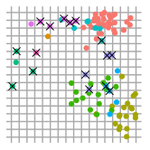Abstract
Assessment of the rate of species loss, which we also label extinction, is an urgent task. However, the rate depends on spatial grain (average area A) over which it is assessed—local species loss can be on average faster, or slower, than regional or global loss. Ecological mechanisms behind this discrepancy are unclear.
We propose that the relationship between extinction rate and A is driven by a classical ecological phenomenon: density dependent mortality. Specifically, we hypothesize that (i) when per-individual probability of death (Pdeath) decreases with number of individuals in a region N (i.e., negative density dependence), per-species extinction rate (Px) should be high at regional grains, and low locally. (ii) In contrast, when Pdeath increases with N (i.e., positive density dependence), Px should be low regionally, but high locally. (iii) Total counts of extinct species (Ex) should follow a more complex relationship with A, as they also depend on drivers of the species-area relationship (SAR) prior to extinctions, such as intraspecific aggregation, species pools, and species-abundance distributions.
We tested these hypotheses using simulation experiments, the first based on point patterns, the second on a system of generalized Lotka-Volterra equations. In both experiments, we used a single continuous parameter that moved between the negative, zero, and positive relationship between Pdeath and N.
We found support for our hypotheses, but only when regional species-abundance distributions were uneven enough to provide sufficiently rare or common species for density dependence to act on. In all, we have theoretically demonstrated a mechanism behind different rates of biodiversity change at different spatial grains which has been observed in empirical data.
